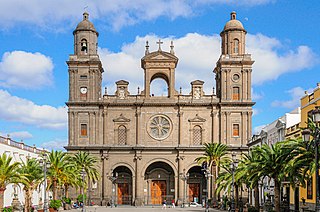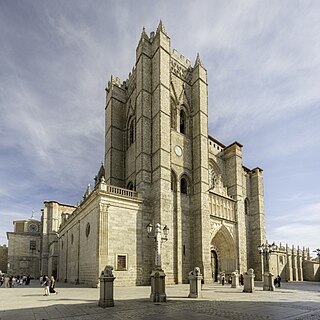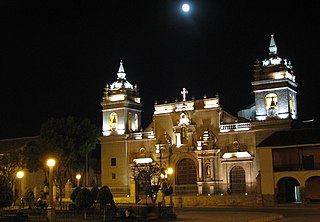
The French Congo or Middle Congo was a French colony which at one time comprised the present-day area of the Republic of the Congo and parts of Gabon, and the Central African Republic. In 1910, it was made part of the larger French Equatorial Africa.
Dralion was a touring production by the Canadian entertainment company Cirque du Soleil. The show combined elements of traditional Chinese circus with Western contemporary circus, complementing the "East-meets-West" theme implied in the title—the name is a portmanteau of "dragon" and "lion". It is Cirque du Soleil's twelfth touring production and the first Cirque show since 1985 not to be directed by Franco Dragone. Dralion performed its final show at the Sullivan Arena in Anchorage, Alaska on January 18, 2015, bringing its fifteen-year world tour to a close.

The Diocese of Ourense is one of five Latin Church dioceses of the Catholic Church in Galicia, northwestern Spain. The Bishop of Ourense has his cathedra in the Catedral de la Virgen Madre de los Milagros in Ourense and his jurisdiction covers all the 28 districts and 735 parishes of the Province of Ourense.

The Metropolitan Archdiocese of Madrid is a Latin archdiocese of the Catholic Church in Spain. It is one of Spain's fourteen metropolitan archbishoprics. Since 12 June 2023 the archbishop of Madrid has been José Cobo Cano.

The Diocese of Cádiz and Ceuta is a Latin Church diocese of the Catholic Church in Spain. The diocese is a suffragan of the Archdiocese of Seville.

The Diocese of Málaga is a Latin Church ecclesiastical jurisdiction or diocese of the Catholic Church in Spain. Its episcopal see is the city of Málaga. The diocese is a suffragan diocese in the ecclesiastical province of the metropolitan Archdiocese of Granada.

The Diocese of Astorga is a Latin Church diocese of the Catholic Church whose seat is in the city of Astorga, in the province of León, Castile and León, Spain.

The Diocese of Córdoba is a Latin Church diocese of the Catholic Church located in the city of Córdoba in the ecclesiastical province of Sevilla in Spain. Bishop Demetrio Fernández González is the current bishop of Cordoba.

The Diocese of Canarias or Diocese Canariense-Rubicense is a Latin diocese of the Catholic Church located in the Canary Islands in the ecclesiastical province of Seville in Spain. The dioceses includes the islands of Gran Canaria, Fuerteventura and Lanzarote. However, it does not include the whole archipelago, since the Diocese of Tenerife includes the Province of Santa Cruz de Tenerife. For this reason, the use of the name of the archipelago is currently a very controversial topic in the Canary Islands. It has recently emerged between the society of Lanzarote the desire to recover the diocesan headquarters of San Marcial del Rubicón.

The Diocese of Mallorca (Latin: Dioecesis Maioricensis is a Latin Church diocese of the Catholic Church located in the city of Palma, Majorca in the ecclesiastical province of Valencia in Spain.

The Diocese of Sigüenza-Guadalajara is a Latin Church diocese of the Catholic Church located in the cities of Sigüenza and Guadalajara, Spain in the ecclesiastical province of Toledo in Spain. It is in the located in the secular Spanish province of Guadalajara in Castile, central Spain. It is bounded on the north by Soria, on the east by Zaragoza and Teruel, on the south by Cuenca and on the west by Guadalajara and Segovia.

The Diocese of Ávila is a Latin diocese of the Catholic Church located in the city of Ávila in the ecclesiastical province of Valladolid in Spain.

The Diocese of Segovia is a Latin diocese of the Catholic Church located in the city of Segovia in the ecclesiastical province of Valladolid in Spain.

The Roman Catholic Archdiocese of Ayacucho o Huamanga is an archdiocese located in the city of Ayacucho in Peru.

The Roman Catholic Archdiocese of Agra is a Latin Metropolitan archdiocese in northern India's Uttar Pradesh state. It comproses the following districts in Uttar Pradesh: Agra, Aligarh, Auraiya, Budaun, Bulandshahr, Etah, Etawah, Farrukabad, Firozabad, Gautambudha Nagar, Hathras, Kannauj, Mainpuri, Mathura and in Rajasthan: Bharatpur and Dholpur.

Bikaner State was a princely state in the Rajputana from 1465 to 1947. The founder of the state, Rao Bika, was the eldest son of Rao Jodha, ruler of Jodhpur. Rao Bika chose to build his own kingdom instead of inheriting his father's. Bika defeated the Jat clans of Jangladesh along with his uncle Rao Kandhal and his adviser Vikramji Rajpurohit and founded his own kingdom. Its capital was the city of Bikaner in the northern area of present-day Rajasthan State in India. Karni Mata has been designated as the kuldevi of the royal family of Bikaner.
The Diocese of Levello was a Roman Catholic diocese in southern Italy, located in the city of Lavello, province of Potenza, in the region of Basilicata. In 1818, it was suppressed, and its territory and members incorporated in the Diocese of Venosa.
















